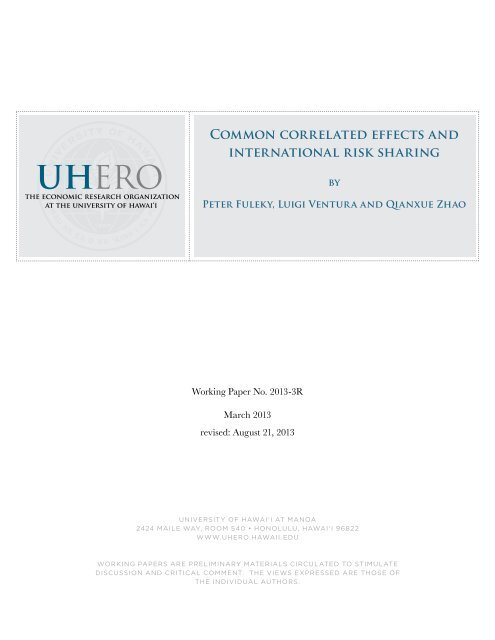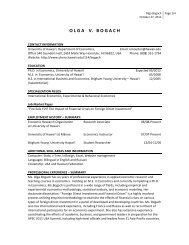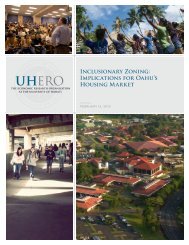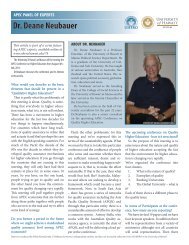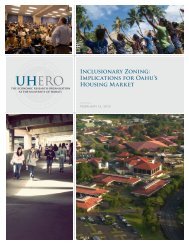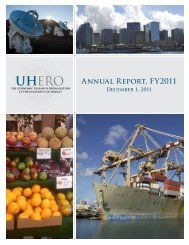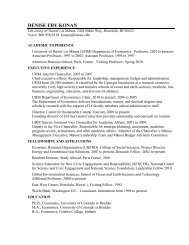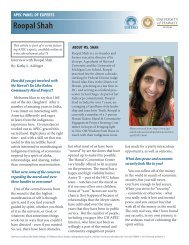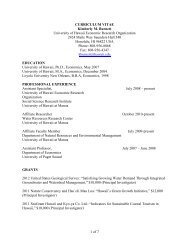Common correlated effects and international risk sharing - UHERO
Common correlated effects and international risk sharing - UHERO
Common correlated effects and international risk sharing - UHERO
You also want an ePaper? Increase the reach of your titles
YUMPU automatically turns print PDFs into web optimized ePapers that Google loves.
<strong>Common</strong> <strong>correlated</strong> <strong>effects</strong> <strong>and</strong><strong>international</strong> <strong>risk</strong> <strong>sharing</strong>byPeter Fuleky, Luigi Ventura <strong>and</strong> Qianxue ZhaoWorking Paper No. 2013-3RMarch 2013revised: August 21, 2013University of Hawai‘i at Manoa2424 Maile Way, Room 540 • Honolulu, Hawai‘i 96822www.uhero.hawaii.eduWorking papers are preliminary materials circulated to stimulatediscussion <strong>and</strong> critical comment. The views expressed are those ofthe individual authors.
<strong>Common</strong> Correlated Effects <strong>and</strong>International Risk Sharing*P. Fuleky , **L. Ventura, ***Q. Zhao*<strong>UHERO</strong> <strong>and</strong> Department of Economics, University of Hawaii at Manoa**Department of Economics <strong>and</strong> Law, Sapienza, University of Rome*** Department of Economics, University of Hawaii at ManoaAugust 21, 2013AbstractExisting studies of <strong>risk</strong> pooling among groups of countries are predicated upon thehighly restrictive assumption that all countries have symmetric responses to aggregateshocks. We show that the conventional <strong>risk</strong> <strong>sharing</strong> test fails to isolate idiosyncraticfluctuations within countries <strong>and</strong> produces spurious results. To avoid these problems,we propose an alternative form of the <strong>risk</strong> <strong>sharing</strong> test that is robust to heterogeneouscountry characteristics. In our empirical example, we provide estimates using the proposedapproach for various groupings of 158 countries.Keywords: Panel data, Cross-sectional dependence, International <strong>risk</strong> <strong>sharing</strong>, ConsumptioninsuranceJEL codes: C23, C51, E21, F361
1 IntroductionSince the early contributions by Cochrane (1991), Mace (1991), <strong>and</strong> Obstfeld (1994), varioustests of consumption <strong>risk</strong> <strong>sharing</strong> have been presented in the literature.The underlyingtheory suggests that if a country has full access to <strong>risk</strong> <strong>sharing</strong> opportunities, consumptionwill be independent of domestic income shocks <strong>and</strong> follow aggregate consumption in thereference area. With idiosyncratic <strong>risk</strong> diversified away, consumption growth rates becomeperfectly <strong>correlated</strong> across individual countries.Although countries are only affected by aggregate <strong>risk</strong> under the <strong>risk</strong> <strong>sharing</strong> hypothesis,the impact of global shocks may not have a uniform distribution across across the world.Because of differences in their productive <strong>and</strong> financial structure, regulations, <strong>and</strong> theirparticipation in <strong>international</strong> trade, countries may be affected by aggregate shocks to varyingdegrees.For example, a country with a disproportionally large export sector may facegreater fluctuations caused by aggregate sources than a country that does not participate in<strong>international</strong> trade. In principle, due to their structure, some countries might not be exposedto aggregate <strong>risk</strong> at all, or may exhibit an inverse relationship, in that their GDP could reactcounter-cyclically to common <strong>risk</strong> factors. A distinguishing feature of our paper is that wetake into account such variation in the impact of global shocks across countries.We propose an alternative approach for testing the <strong>risk</strong> <strong>sharing</strong> hypothesis within a heterogeneousset of economies. To be able to determine whether consumption is smoothed by<strong>international</strong> <strong>risk</strong> <strong>sharing</strong>, one first needs to disentangle the common <strong>and</strong> idiosyncratic shocksaffecting individual countries. We argue that the appropriate method for filtering out theunobserved common factors from the observed variables should allow for the heterogeneity ofcountries in terms of their exposure to aggregate <strong>risk</strong>. In contrast to the existing literature,we let global factors have country specific <strong>effects</strong> on the analyzed variables. Consequently,our approach is better able to isolate idiosyncratic shocks than the cross-sectional demeaningmethod conventionally used in <strong>risk</strong> <strong>sharing</strong> tests.Similarly to other empirical studies, we find little evidence in support of full <strong>international</strong>2
isk pooling. Idiosyncratic <strong>risk</strong> may not be eliminated for a variety of reasons, includingincomplete financial or real markets, limited participation in those markets, absence of intraor inter generational transfers, <strong>and</strong> limited saving opportunities.Still, even though fullinsurance appears to be a theoretical curiosity in the absence of complete markets, studyingthe extent to which idiosyncratic <strong>risk</strong> affects consumption can shed light on the attaineddegree of diversification. The rest of the paper is organized as follows: Section 2 reviewsthe theoretical background of <strong>risk</strong> <strong>sharing</strong> tests, Section 3 introduces our empirical strategy,Section 4 discusses the results, <strong>and</strong> Section 5 concludes.2 Theoretical BackgroundRegression based <strong>risk</strong> <strong>sharing</strong> (or consumption insurance) tests are based on the null hypothesisof market completeness, or the possibility to redistribute wealth (hence, consumption)across all date-event pairs. Under market completeness, the solution to the representativeagent’s maximization problem ensures that marginal utility growth is equalized across agents,<strong>and</strong> depends on aggregate factors but not on individual shocks (Cochrane, 1991; Mace, 1991;Obstfeld, 1994). Assuming CRRA utility functions, the <strong>risk</strong> <strong>sharing</strong> hypothesis can be basedon estimating the following equationc it = α i + γ c i ¯c t + β i x it + ε it , i = 1 . . . N, t = 1 . . . T , (1)where c it is a consumption measure for country i, ¯c·t is an aggregate measure of consumption,<strong>and</strong> x it is an idiosyncratic variable. Market completeness implies γi c > 0 <strong>and</strong> β i = 0. If thediscount factors <strong>and</strong> the coefficients of relative <strong>risk</strong> aversion are assumed to be equal acrosscountries, the coefficients γi c can be shown to take a unit value. However, such homogeneityis unlikely in reality: Obstfeld (1989) found some evidence against the hypothesis of γi c = 1even in countries with similar characteristics, such as Germany, Japan <strong>and</strong> the United States.Nevertheless, most papers in the field have built on these assumptions, under which the test3
equation becomesc it − ¯c t = α i + β i x it + ε it . (2)The consumption <strong>risk</strong> <strong>sharing</strong> test is based on the null hypothesis H 0 : β i = 0, where β i canbe regarded as the extent of the departure from perfect <strong>risk</strong> <strong>sharing</strong>. The rejection of the nullhypothesis implies that agents do not use an insurance mechanism to fully offset idiosyncraticshocks to their endowments, which are consequently transmitted to consumption. Asdrubaliet al. (1996); Crucini (1999); Crucini <strong>and</strong> Hess (2000); Grimard (1997); Jalan <strong>and</strong> Ravallion(1999) <strong>and</strong> many others in the last decade have gone even further by suggesting that therelative size of the estimated slope coefficient can be interpreted as a measure of the degreeof insurance or <strong>risk</strong> pooling.In virtually all macroeconomic implementations of equation (2), the variable x it containingidiosyncratic shocks is replaced by a proxy for idiosyncratic income, which in turn iscalculated as a difference between the individual country’s income <strong>and</strong> a measure of aggregateincome. With these modifications the tested relationship becomesc it − ¯c t = α i + β i (y it − ȳ t ) + ε it , (3)where y it is an income measure for country i, <strong>and</strong> ȳ·t is a measure of aggregate income.Equation (3) is the basis for several recent influential empirical studies, such as Sorensen<strong>and</strong> Yosha (2000), Giannone <strong>and</strong> Reichlin (2006), Sorensen et al. (2007), <strong>and</strong> Kose et al.(2009) among others. In these studies, the consumption <strong>and</strong> income measures enteringthe analysis are consumption growth <strong>and</strong> real gross domestic product (GDP) growth, respectively.Correspondingly, β i can be interpreted as the effect of idiosyncratic real GDPgrowth on idiosyncratic consumption growth in country i. If the aggregates, ¯c·t <strong>and</strong> ȳ·t , arecross-sectional means, then the differencing operations in equation (3) will produce crosssectionallydemeaned variables. Other studies, for example Asdrubali et al. (1996), Lewis(1997), Sorensen <strong>and</strong> Yosha (1998), <strong>and</strong> Fratzscher <strong>and</strong> Imbs (2009), replace the explicit4
cross-sectional demeaning in equation (3) with an implicit one by including a time dummyd t in the pooled regressionc it = α i + d t + βy it + ε it . (4)Artis <strong>and</strong> Hoffmann (2007) derive equation (3) by relying on an alternative theoreticalframework proposed by Crucini (1999). They model country specific income, y it , as a mixtureof the level of pooled real GDP in participating countries <strong>and</strong> the level of domestic real GDP.They obtain their results for the perfectly symmetric case where each country is assumedto pool the same proportion of its income. However, similarly to the assumption of equaldiscount factors <strong>and</strong> coefficients of <strong>risk</strong> aversion across countries in the classical framework,this assumption is also likely to be overly restrictive when the analysis is carried out with aheterogeneous set of economies.We propose to deal with the cross-sectional variation in country characteristics <strong>and</strong> theestimation of idiosyncratic <strong>effects</strong> by taking advantage of an unobserved component model.Although neither aggregate nor idiosyncratic shocks are directly measured, a particular country’sobserved income, y it , can be decomposed into two analogous unobserved components.By definition, pooled income will follow global cycles that can be captured by common factors,f t , <strong>and</strong> its contribution to a particular country’s observed income can be measured bythe factor loadings, λ i,y ,y it = λ ′ i,yf t + ξ y it , (5)where λ i,y allows countries to be heterogeneous in terms of their sensitivity to global shocks.The term λ ′ i,yf t yields the amount of fully diversified income for country i, <strong>and</strong> the balance,ξ y it = y it − λ ′ i,yf t , is the idiosyncratic income. Applying a similar logic to the calculationof idiosyncratic consumption, <strong>and</strong> approximating the common factors with cross-sectionalmeans of the variables, we obtain the more general modelc it − γ c i ¯c t = α i + β i (y it − ˜γ y i ȳt) + ε it , (6)5
orc it = α i + β i y it + γ c i ¯c t + γ y i ȳt + ε it , (7)where the β i coefficient measures the extent to which idiosyncratic shocks to income arechanneled into idioscyncratic consumption. The country specific γ y i = −β i˜γ y i <strong>and</strong> γi c coefficientsallow the amount of income <strong>and</strong> consumption driven by global shocks to vary acrosscountries. A more detailed discussion of this model follows in Section 3.When countries are heterogeneous in terms of their pooled resources <strong>and</strong> their sensitivityto aggregate fluctuations, consumption insurance tests based on equations (3) or (4) maysuffer from inadequate h<strong>and</strong>ling of global shocks <strong>and</strong> produce misleading inference. Specifically,<strong>risk</strong> <strong>sharing</strong> tests require the isolation of idiosyncratic shocks, but simple cross-sectionaldifferencing with respect to an aggregate measure may be insufficient for this purpose if theeffect of global shocks varies across countries.In Section 3 we describe in greater detailthe proposed approach to deal with cross-sectional dependence among heterogeneous countries.Our method parallels the common <strong>correlated</strong> <strong>effects</strong> (CCE) estimator of Pesaran(2006), which was shown to be an effective tool for eliminating common factors from linearrelationships in heterogeneous panels.3 Empirical StrategyThe <strong>international</strong> <strong>risk</strong> <strong>sharing</strong> hypothesis postulates that consumption across countries followsa similar pattern, <strong>and</strong> deviations from this pattern cannot be predicted by idiosyncraticexplanatory variables. The presence of a similar pattern across countries can be tested by thecross-sectional dependence (CD) statistic of Pesaran (2004). This test is based on the pairwisecorrelation of the cross-sectional units, <strong>and</strong> has been shown to have good finite sampleproperties in heterogeneous panels. If the null hypothesis of cross-sectional independence isrejected, the co-movement of variables across countries may be modeled by common factors,<strong>and</strong> idiosyncratic components can be obtained by an orthogonal projection of the data onto6
the common factors. These idiosyncratic components can then be tested for predictability.Pesaran’s (2006) common <strong>correlated</strong> <strong>effects</strong> (CCE) estimator, which he proposed to dealwith dependencies across units in heterogeneous panels, is an ideal tool for estimating β i , theeffect of idiosyncratic income on idiosyncratic consumption. The CCE estimator lends itselfto this task because it accounts for common factors, such as global cycles, allows for individualspecific <strong>effects</strong> of these factors, <strong>and</strong> produces coefficient estimates based on idiosyncraticfluctuations in the data.Specifically, the CCE estimator asymptotically eliminates thecross-sectional dependence caused by common factors in the panel regressionc it = α i + β i y it + u it , i = 1, 2, . . . , N , t = 1, 2, . . . , T . (8)The regressor, y it , is assumed to be generated asy it = a i,y + λ ′ i,yf t + ξ y it , (9)where a i,y is an individual effect, <strong>and</strong> f t is an m × 1 vector of unobserved common <strong>effects</strong>with individual specific loading vector λ i,y . The idiosyncratic component ξ y itis distributedindependently of the common <strong>effects</strong> <strong>and</strong> across i, <strong>and</strong> is assumed to follow a covariancestationary process. The error term u it is assumed to have the following structureu it = ω ′ if t + ε it , (10)where ω i is a m × 1 loading vector capturing the individual specific effect of the commonfactors f t , <strong>and</strong> ε it are idiosyncratic errors assumed to be distributed independently of y it<strong>and</strong> f t .The error term, u it , is allowed to be <strong>correlated</strong> with the regressor, y it , throughthe presence of the factors in both, <strong>and</strong> failure to account for this correlation will generallyproduce biased estimates of the parameters of interest. Pesaran (2006) suggested using crosssection averages of c it <strong>and</strong> y it to deal with the <strong>effects</strong> of the unobserved factors. His CCE7
estimator is defined as,ˆβ i = (y ′ i¯My i ) −1 y ′ i¯Mc i , (11)where y i = (y i1 , y i2 , . . . , y iT ) ′ , c i = (c i1 , c i2 , . . . , c iT ) ′ , <strong>and</strong>¯M = I T − ¯H( ¯H ′ ¯H) −1 ¯H ′ with¯H = (ι, ȳ, ¯c). I T is a T × T identity matrix, <strong>and</strong> ι is a T × 1 vector of ones. ȳ is a T × 1matrix of cross-sectional means of the regressor, <strong>and</strong> ¯c is a T × 1 vector of cross-sectionalmeans of the dependent variable. The term¯My i acts as an “instrument” that controls forthe unobserved common factors in the variables <strong>and</strong> the errors.The CCE estimator is equivalent to ordinary least squares applied to an auxiliary regressionaugmented with the cross-sectional means of the variables. In other words, (11) appliedto (8) produces β i estimates that are identical to ordinary least squares estimates of β i inour proposed model (7). The CCE estimator partitions the regression in (7) by projectingconsumption <strong>and</strong> income orthogonally with respect to their cross-sectional means using the¯M matrix. The estimation can be broken down into two stages. In the first stage, the common<strong>effects</strong> are filtered out from the data by regressing each variable on the cross-sectionalaverages of all variables in the modelc it = a i,c + λ c i,c¯c t + λ y i,cȳt + ξ c it , (12)y it = a i,y + λ c i,y¯c t + λ y i,yȳt + ξ y it . (13)In the second stage, the CCE estimate of an individual β i is obtained by regressing theresidual ˆξ it, c capturing idiosyncratic consumption, on the residual ˆξ y it , capturing idiosyncraticincome. Because the consumption <strong>and</strong> income aggregates tend to be highly collinear, theλ coefficients in (12) <strong>and</strong> (13) are estimated imprecisely <strong>and</strong> therefore can not be meaningfullyinterpreted. However, as collinearity does not affect the residuals, ˆξ c it <strong>and</strong> ˆξ y itcan beconsidered valid estimates of the idiosyncratic components <strong>and</strong> can be compared to crosssectionallydemeaned consumption <strong>and</strong> income. The latter may not be free of aggregateshocks: if the effect of global cycles varies across countries, cross-sectional demeaning will8
not be able to isolate the idiosyncratic variation in the data <strong>and</strong> will therefore lead to biasedconclusions about the extent of <strong>risk</strong> <strong>sharing</strong>.Most empirical analyses focus on testing the <strong>risk</strong> <strong>sharing</strong> hypothesis with differenceddata. However, several recent studies, including Becker <strong>and</strong> Hoffmann (2006) <strong>and</strong> Artis <strong>and</strong>Hoffmann (2012), have examined the implications of <strong>risk</strong> <strong>sharing</strong> in the long run by exploitingthe information contained in the levels of the variables. Conveniently, our proposed testingprocedure does not depend on the transformation of the variables: Kapetanios et al. (2010)proved that the CCE estimators are consistent regardless of whether the common factors,f t , are stationary or non-stationary. However, consistent estimation of the model parametersrequires that the regression residuals be stationary. The rejection of a unit root in ε it (inequations 7 <strong>and</strong> 10) implies that c it , y it , <strong>and</strong> f t are cointegrated.As illustrated by Leibrecht <strong>and</strong> Scharler (2008) <strong>and</strong> Pierucci <strong>and</strong> Ventura (2010), cointegrationcan be exploited in an error correction model to obtain additional information about<strong>risk</strong> <strong>sharing</strong>. For an individual country, the deviation from the long run equilibrium relationshipbetween idiosyncratic income <strong>and</strong> consumption is captured by the residual, ˆε it , inequation (7). The speed at which this equilibrium error is corrected, κ, can then be estimatedalong with the extent of <strong>risk</strong> <strong>sharing</strong> in the short run, βiSR , in the following error-correctionmodelorwhere ˆε LRit∆c it − γ c,SRi ∆c t = αiSR + κˆε LRit∆c it = α SRi= c it − ˆα iLR −ˆβLRi+ κˆε LRity it −ˆγ c,LRi+ β SRi+ β SRi∆y it + γ c,SRi(∆y it − ˜γ y,SRi ∆y t ) + ε SRit , (14)∆c t + γ y,SRi ∆y t + ε SRit , (15)¯c t −ˆγ y,LRi ȳ t . Short run <strong>risk</strong> <strong>sharing</strong> tests also require theisolation of idiosyncratic <strong>effects</strong>. Here, the heterogeneous impact of global shocks is filteredout by including in the regression the cross-sectional means of differenced consumption <strong>and</strong>income, ∆c t <strong>and</strong> ∆y t , with country specific coefficients, γ c,SRi<strong>and</strong> γ y,SRi , respectively.Under a r<strong>and</strong>om coefficient model, the simple averages of the individual CCE estimators9
of β LRi<strong>and</strong> β SRiare consistent estimators of the overall β LR <strong>and</strong> β SR , respectively. Thesemean group estimators are defined asˆβ LRMG = 1 NN∑i=1ˆβ LRi <strong>and</strong> ˆβSR MG = 1 NN∑i=1ˆβ SRi . (16)The CCE estimator admits both simple <strong>and</strong> weighted cross-sectional averages in the ¯Mmatrix. However, unequal weights may distort inference if they overstate the importance ofoutliers in the cross-sectional distribution of the data. For example, if a variable of interestis in per capita terms, each country could be weighted by its population share, so that theaggregate becomes a global per capita measureN∑i=1(C it ∗ w it ) = ¯C t , w it = N itN t, i = 1, 2, . . . , N , t = 1, 2, . . . , T , (17)where C st<strong>and</strong>s for consumption per capita, <strong>and</strong> N st<strong>and</strong>s for population. This weightingscheme overweights countries with large population. If some of these countries are atypicalin terms of their participation in the global pool of resources, inference will be distorted.Specifically, if the proxies for the common factors are biased towards outliers, the CCEprocedure will not be able to isolate the idiosyncratic <strong>effects</strong> in individual countries <strong>and</strong>eliminate cross-sectional dependence in the panel.An additional source of bias may be the log-transformation required by most macroeconomicvariables, such as consumption <strong>and</strong> income, before they can be analyzed in linearmodels. Such non-linear transformation will affect the location of the aggregate measurerelative to the cross-sectional distribution of the country level variables, <strong>and</strong> further distortinference. These complications can be avoided if the cross-sectional means entering the¯Mmatrix are obtained by applying simple averages to previously log-transformed country levelseries. Having described the correspondence between our proposed testing approach <strong>and</strong> theCCE methodology, we now turn to our empirical study <strong>and</strong> report estimation results in thenext section.10
4 Data <strong>and</strong> ResultsOur analysis is based on annual data obtained from the Penn World Tables, version 7.1,released in November 2012 (Heston et al., 2012). This is a comprehensive dataset, coveringmore than 170 countries over a fairly long time span. We use the sub-period 1970 - 2010,which yields 158 countries with continuously available annual data. The analysis of sucha large heterogeneous panel is a distinguishing feature of our study; the existing literaturelargely focuses on smaller sets of rather homogeneous countries.[Insert Table 1 about here]From the Penn World Tables we use purchasing power parity converted GDP per capita<strong>and</strong> consumption per capita at 2005 constant prices. The analyzed series are comparable tothose in other datasets, such as the World Bank’s World Development Indicators. They areexpressed in real terms in a common currency, so as to make comparisons across countries<strong>and</strong> time feasible. Because these variables tend to exhibit exponential growth, we apply a logtransformationto them in our analysis. The diagnostic statistics displayed in Table 1 indicatethat the log transformed consumption <strong>and</strong> income levels are cross-sectionally dependent <strong>and</strong>non-stationary. The log-differenced series are also cross-sectionally dependent, but they donot contain unit roots.[Insert Table 2 about here]Table 2 displays the results of diagnostic tests applied to the residuals in equations (3),(7), <strong>and</strong> (15). The first two regressions are evaluated with both the data in log-levels <strong>and</strong> inlog-differences. To verify the robustness of the results, we repeat the analysis for a truncatedsample excluding the Great Recession. In each regression, we test the residuals for crosssectionaldependence <strong>and</strong> non-stationarity. For the former, we use the CD statistic proposed11
y Pesaran (2004). For the latter, we use the CIP S statistic of Pesaran (2007), <strong>and</strong> if the CDtest rejects the null hypothesis of cross-sectional independence, we test the cross-sectionalaverage of the residuals for unit roots using the CRMA test of Sul (2009).The rejection of the CD test for the residuals of the cross-sectionally demeaned regressionsindicates that equation (3) is not able to fully isolate the idiosyncratic fluctuations in thevariables.In other words, the unit coefficients imposed on the aggregates do not reflectthe true influence of global shocks on country level variables, <strong>and</strong> they give rise to residualcommon factors in the regression. 1The estimated coefficients will be biased if the globalshocks are not fully filtered out from the variables because ˆβ i will, at least in part, attributeaggregate fluctuations in consumption to aggregate fluctuations in income. Global factorsare essentially lurking variables that confound the relationship between the regressor <strong>and</strong>the dependent variable. Moreover, when the regression is based on variables in log-levels<strong>and</strong> the CD test rejects cross sectional independence, the CRMA test indicates that thecommon factors remaining in the residuals contain unit roots. Consequently, our diagnostictests indicate that only models augmented by simple cross-sectional averages, equations (7)<strong>and</strong> (15), yield statistically acceptable results.Given their great diversity, the countries in our analysis vary in terms of their susceptibilityto global shocks. If the countries were homogeneous, in terms of <strong>risk</strong> aversion, timepreference <strong>and</strong> endowments, the global shocks would have a unit loading for each country,<strong>and</strong> cross-sectional demeaning would be an appropriate method to calculate the idiosyncraticcomponents. However, when they are heterogeneous, <strong>and</strong> the impact of global shocks differsacross countries, the first stage regressions (12) <strong>and</strong> (13) are more appropriate to estimateidiosyncratic variation. To illustrate the disagreement between the two methods in our heterogeneousdata set, we examine the correlation of the idiosyncratic components estimated1 This also remains the case when the common trends are approximated by population weighted crosssectionalaverages. In fact, under the population weighting scheme even the residuals in equations (7)<strong>and</strong> (15) are cross-sectionally dependent, which suggests that some countries with large population are nottypical in terms of <strong>risk</strong> <strong>sharing</strong>. Under these circumstances, population weights are inappropriate for theapproximation of common factors in per capita GDP <strong>and</strong> consumption.12
y the first stage regressions <strong>and</strong> cross-sectional demeaning.[Insert Figure 1 about here]Figure 1 shows the distribution of the correlation coefficients Cor(ˆξ it, c c it −¯c t ) <strong>and</strong> Cor(ˆξ y it , y it−ȳ t ) when the data is in log-levels. The correlation between the two types of estimates of theidiosyncratic components is below 0.80 for over two thirds of the countries. The correlationis close to unity if the country specific income <strong>and</strong> consumption closely mimic their aggregatecounterparts, but close to zero when a country is not influenced by global shocks. In theformer case both methods can successfully eliminate the global <strong>effects</strong>. However, in the lattercase, c it − ¯c t <strong>and</strong> y it − ȳ t introduce mirror images of the global shocks into the demeanedvariables, while ˆξ c it <strong>and</strong> ˆξ y itremain void of global shocks.[Insert Figure 2 about here]Figure 2 illustrates the evolution of scaled idiosyncratic components <strong>and</strong> demeaned variables,<strong>and</strong> it is evident that the latter are trending in many instances. Those trends areeither introduced or not fully removed by cross-sectional demeaning. The trends show up onboth the left <strong>and</strong> the right h<strong>and</strong> side of equation (3), which leads to a bias in the β i estimatesfor two reasons. First, ˆβ i attributes the trend in consumption to the trend in income. Second,the diagnostic tests of the regression residuals in Table 2 imply that cross-sectionallydemeaned income <strong>and</strong> consumption are not cointegrated, <strong>and</strong> the β i estimates are spurious.When the model in equation (3) is evaluated with log-differenced series, the β i estimates donot suffer from the issues related to non-stationarity, but they are influenced by the lingeringaggregate <strong>effects</strong> in the cross-sectionally demeaned data. These illustrations further corroborateour earlier finding that imposing a unit loading coefficient on the aggregates leaves thedemeaned regression misspecified <strong>and</strong> incapable of filtering out the common factors from ourheterogeneous panels.13
[Insert Table 3 about here]We now turn to the discussion of the statistically defensible coefficient estimates. Table 3displays the mean group estimates of <strong>risk</strong> <strong>sharing</strong> behavior for a variety of country groups.In line with earlier studies, our overall results based on the whole sample indicate thatconsumption tends to be affected by idiosyncratic shocks in both the long <strong>and</strong> the shortrun, <strong>and</strong> the extent of <strong>risk</strong>-<strong>sharing</strong> tends to be higher in the short run.The fraction ofidiosyncratic variation in GDP channelled to consumption is about 0.70 in the short-run,while it is slightly above 0.80 in the long run. Our results reveal a geo-economic pattern thatis similar to the one found by Kose et al. (2009) who analyzed 69 countries over the 1960-2004 period. In particular, ˆβ LR <strong>and</strong> ˆβ SR are inversely related to the level of development,which signals a greater capacity of developed economies to insure against idiosyncratic <strong>risk</strong>.Our estimates for OECD countries are quite similar to those obtained by Leibrecht <strong>and</strong>Scharler (2008) who also used an error correction model: our ˆβ LR = 0.68 <strong>and</strong> ˆβ SR = 0.80 fallsomewhat below their estimates of about 0.7 <strong>and</strong> 0.9, respectively. However, our estimatedspeed of equilibrium-error correction, ˆκ = −0.31, deviates from their -0.1 estimate by alarger margin 2 . Consequently, the mean adjustment lag (computed as ˆµ = (1 − ˆβ SR )/(−ˆκ)based on Hendry, 1995) indicates that in OECD countries an income shock exerts its fulleffect on consumption within about a year according to our study <strong>and</strong> in about three yearsaccording to the results of Leibrecht <strong>and</strong> Scharler (2008). In Table 3 the mean adjustmentlag is also inversely related to the level of development, <strong>and</strong> it is the shortest in low incomecountries, where consumption appears to react to income shocks faster, perhaps due to aweaker institutional framework, fewer consumption smoothing opportunities, or a lack ofaccess to financial markets.[Insert Figure 3 about here]2 Notice, however, that the time period analyzed by Leibrecht <strong>and</strong> Scharler (2008) is different from ours.14
Figure 3 illustrates the distribution of individual β i ’s. It is immediately obvious that thereis a remarkable heterogeneity among countries in terms of their <strong>risk</strong>-<strong>sharing</strong> coefficients, bothin the long run <strong>and</strong> in the short run.[Insert Table 4 <strong>and</strong> 5 about here]Table 4 <strong>and</strong> 5 list the values of the country specific β LRifull insurance is extremely rare. More than 95% of the β LRi<strong>and</strong> β SRiestimates. As expected,<strong>and</strong> almost 90% of the β SRiestimatesare significantly different from zero, which indicates a widespread lack of consumption<strong>risk</strong> <strong>sharing</strong>. The degree of <strong>risk</strong> <strong>sharing</strong> tends to be lower in the long run for most countries.In fact, 33 of the analyzed countries have 50% higher coefficient estimates in the long runthan in the short run, <strong>and</strong> over 45 of them appear to exhibit dis-smoothing behavior (β i > 1)in the long run, whereas only 27 do so in the short run.5 ConclusionInternational <strong>risk</strong> <strong>sharing</strong> tests are based on the premise that under complete markets countryspecific consumption should not be affected by idiosyncratic income shocks. A prerequisitefor these tests is the isolation of idiosyncratic fluctuations in the variables. The existing literaturetypically employs cross-sectional demeaning to filter out global shocks from consumption<strong>and</strong> income panels, but the validity of that method relies on the restrictive assumptionof symmetric country characteristics. In general, demeaning is not capable of eliminatingcross-sectional dependence from a heterogeneous data set. And inadequate h<strong>and</strong>ling of commonfactors can lead to misleading inference because the estimated coefficient will attributeaggregate fluctuations in consumption to aggregate fluctuations in income.We suggest that a statistically more appropriate technique is to control for global factorsby allowing for heterogeneous loading coefficients within an unobserved componentsframework that parallels the CCE methodology of Pesaran (2006) <strong>and</strong> Kapetanios et al.15
(2010). In our empirical example, we illustrate the inadequacy of cross-sectional demeaning<strong>and</strong> provide estimates for 158 countries <strong>and</strong> various country groupings using the proposedapproach. Our results largely confirm the findings of the existing literature that full <strong>risk</strong><strong>sharing</strong> is almost never achieved, <strong>and</strong> that the degree of <strong>risk</strong> <strong>sharing</strong> tends to be lower in thelong run.16
ReferencesArtis, M. <strong>and</strong> Hoffmann, M. (2007).The home bias <strong>and</strong> capital income flows betweencountries <strong>and</strong> regions. CEPR Discussion Papers, (5691).Artis, M. <strong>and</strong> Hoffmann, M. (2012). The home bias, capital income flows <strong>and</strong> improved longtermconsumption <strong>risk</strong> <strong>sharing</strong> between industrialized countries. International Finance,14(3):481–505.Asdrubali, P., Sorensen, B. E., <strong>and</strong> Yosha, O. (1996). Channels of interstate <strong>risk</strong> <strong>sharing</strong>:United States 1963-1990. The Quarterly Journal of Economics, 111(4):1081–1110.Becker, S. O. <strong>and</strong> Hoffmann, M. (2006). Intra- <strong>and</strong> <strong>international</strong> <strong>risk</strong>-<strong>sharing</strong> in the shortrun <strong>and</strong> the long run. European Economic Review, 50(3):777–806.Cochrane, J. H. (1991). A simple test of consumption insurance. Journal of Political Economy,99(5):957–76.Crucini, M. J. (1999). On <strong>international</strong> <strong>and</strong> national dimensions of <strong>risk</strong> <strong>sharing</strong>. The Reviewof Economics <strong>and</strong> Statistics, 81:73–84.Crucini, M. J. <strong>and</strong> Hess, G. D. (2000). International <strong>and</strong> intranational <strong>risk</strong> <strong>sharing</strong>. Intranationalmacroeconomics, pages 37–59.Fratzscher, M. <strong>and</strong> Imbs, J. (2009). Risk <strong>sharing</strong>, finance, <strong>and</strong> institutions in <strong>international</strong>portfolios. Journal of Financial Economics, 94(3):428–447.Giannone, D. <strong>and</strong> Reichlin, L. (2006).Trends <strong>and</strong> cycles in the euro area: how muchheterogeneity <strong>and</strong> should we worry about it?Working Paper Series, European CentralBank, (595).Grimard, F. (1997). Household consumption smoothing through ethnic ties: evidence fromcote d’ivoire. Journal of Development Economics, 53(2):391–422.17
Hendry, D. F. (1995). Dynamic Econometrics. Oxford University Press.Heston, A., Summers, R., <strong>and</strong> Aten, B. (2012). Penn world table version 7.1. Center forInternational Comparisons of Production, Income <strong>and</strong> Prices.Jalan, J. <strong>and</strong> Ravallion, M. (1999). Are the poor less well insured? evidence on vulnerabilityto income <strong>risk</strong> in rural china. Journal of development economics, 58(1):61–81.Kapetanios, G., Pesaran, H., <strong>and</strong> Yamagata, T. (2010). Panels with nonstationary multifactorerror structures. Journal of Econometrics.Kose, M. A., Prasad, E. S., <strong>and</strong> Terrones, M. E. (2009). Does financial globalization promote<strong>risk</strong> <strong>sharing</strong>? Journal of Development Economics, 89(2):258–270.Leibrecht, M. <strong>and</strong> Scharler, J. (2008).Reconsidering consumption <strong>risk</strong> <strong>sharing</strong> amongoecd countries: some evidence based on panel cointegration. Open Economies Review,19(4):493–505.Lewis, K. K. (1997).Are countries with official <strong>international</strong> restrictions ’liquidity constrained’?European Economic Review, 41(6):1079–1109.Mace, B. J. (1991). Full insurance in the presence of aggregate uncertainty. Journal ofPolitical Economy, 99(5):928–56.Obstfeld, M. (1989). How integrated are world capital markets: Some new tests. in debt, stabilization<strong>and</strong> development: Essays in memory of carlos diaz-alej<strong>and</strong>ro., National Bureauof Economic Research, Inc.Obstfeld, M. (1994). Are industrial-country consumption <strong>risk</strong>s globally diversified? NBERWorking Papers 4308, National Bureau of Economic Research, Inc.Pesaran, M. H. (2004).General diagnostic tests for cross section dependence in panels.CESifo Working Paper Series No. 1229; IZA Discussion Paper No. 1240.18
Pesaran, M. H. (2006).Estimation <strong>and</strong> inference in large heterogeneous panels with amultifactor error structure. Econometrica, 74(4):pp. 967–1012.Pesaran, M. H. (2007). A simple panel unit root test in the presence of cross-section dependence.Journal of Applied Econometrics, 22(2):265–312.Pierucci, E. <strong>and</strong> Ventura, L. (2010). Risk <strong>sharing</strong>: a long run issue? Open EconomiesReview, 21(5):705–730.Sorensen, B. E., Wu, Y.-T., Yosha, O., <strong>and</strong> Zhu, Y. (2007). Home bias <strong>and</strong> <strong>international</strong> <strong>risk</strong><strong>sharing</strong>: Twin puzzles separated at birth. Journal of International Money <strong>and</strong> Finance,26(4):587–605.Sorensen, B. E. <strong>and</strong> Yosha, O. (1998). International <strong>risk</strong> <strong>sharing</strong> <strong>and</strong> european monetaryunification. Journal of International Economics, 45(2):211–238.Sorensen, B. E. <strong>and</strong> Yosha, O. (2000). Is <strong>risk</strong> <strong>sharing</strong> in the united states a regional phenomenon?Economic Review, (Q II):33–47.Sul, D. (2009). Panel unit root tests under cross section dependence with recursive meanadjustment. Economics Letters, 105(1):123–126.19
Table 1: Tests for Individual VariablesLevelsDifferenceslog C log Y ∆ log C ∆ log YCD 253.45 ∗ 239.37 ∗ 22.93 ∗ 43.33 ∗CRMA 2.11 2.08 -3.92 ∗ -3.21 ∗CIP S -0.32 1.87 -9.72 ∗ -7.78 ∗Note: Pesaran’s (2004) cross-sectional independence test (CD) follows a st<strong>and</strong>ard normal distribtion.The 5 % critical value for Pesaran’s (2007) panel unit root test (CIP S) is -2.06. The laglength for the CIP S test is set to T 1/3 = 4. The 5 % critical value for Sul’s (2009) unit root testfor the cross-sectional means (CRMA) is -1.88. The lag length for the CRMA test is determinedby the Bayesian Information Criterion. Statistical significance at the 5% level or lower is denotedby ∗ .20
Table 2: Residual Diagnostic TestsFull Sample (1970-2010)Levels Differences ECMEq. (3) Eq. (7) Eq. (3) Eq. (7) Eq. (15)CD 11.28 ∗ 0.06 22.86 ∗ -0.53 -0.83CRMA -1.74 — -6.02 ∗ — —CIP S -2.03 -5.87 ∗ -8.66 ∗ -10.09 ∗ -10.03 ∗Truncated Sample (1970-2007)Levels Differences ECMEq. (3) Eq. (7) Eq. (3) Eq. (7) Eq. (15)CD 12.68 ∗ 0.36 23.44 ∗ -0.33 -0.48CRMA -1.86 — -5.56 ∗ — —CIP S -0.13 -5.75 ∗ -5.34 ∗ -8.36 ∗ -11.02 ∗Note: Pesaran’s (2004) cross-sectional independence test (CD) follows a st<strong>and</strong>ard normal distribtion.The 5 % critical value for Pesaran’s (2007) panel unit root test (CIP S) is -2.06. The laglength for the CIP S test is set to T 1/3 = 4. The 5 % critical value for Sul’s (2009) unit root testfor the cross-sectional means (CRMA) is -1.88. The lag length for the CRMA test is determinedby the Bayesian Information Criterion. Statistical significance at the 5% level or lower is denotedby ∗ .21
Table 3: Mean Group Coefficient Estimates for Sub-SamplesCountry Group ˆβLR ˆβSR ˆκ ˆµWhole sample 0.83 ∗ 0.71 ∗ -0.39 ∗ 0.74High Income 0.87 ∗ 0.67 ∗ -0.33 ∗ 1.00UpperMid Income 0.85 ∗ 0.73 ∗ -0.41 ∗ 0.66LowerMid Income 0.83 ∗ 0.70 ∗ -0.42 ∗ 0.71Low Income 0.82 ∗ 0.77 ∗ -0.44 ∗ 0.52OECD 0.80 ∗ 0.68 ∗ -0.31 ∗ 1.03Non-OECD 0.84 ∗ 0.72 ∗ -0.42 ∗ 0.67Developed 0.78 ∗ 0.65 ∗ -0.32 ∗ 1.09Developing 0.87 ∗ 0.74 ∗ -0.41 ∗ 0.63Europe 0.79 ∗ 0.67 ∗ -0.34 ∗ 0.97Asia 0.88 ∗ 0.70 ∗ -0.40 ∗ 0.75Africa 0.83 ∗ 0.70 ∗ -0.43 ∗ 0.70Note: Country group definitions follow those used by the World Bank <strong>and</strong> OECD. ˆβLR is obtainedby estimating equation (7) with data in log-levels. ˆβSR is obtained by estimating theerror-correction model in equation (15). ˆκ denotes the estimated speed-of-adjustment coefficient inthe error-correction model. ˆµ denotes the mean adjustment lag computed as ˆµ = (1 − ˆβ SR )/(−ˆκ)based on Hendry (1995). Statistical significance at the 5% level or lower is denoted by ∗ .22
Table 4: Country-Specific Coefficient Estimatesid country β LR β SR id country β LR β SR1 AFG 0.87 ∗ 0.95 ∗ 41 DOM 0.90 ∗ 1.01 ∗2 AGO 2.00 ∗ 0.62 42 DZA 1.48 ∗ 0.243 ALB 0.18 ∗ 0.29 ∗ 43 ECU 0.71 ∗ 0.57 ∗4 ARG 0.97 ∗ 1.26 ∗ 44 EGY 0.68 ∗ 0.375 ATG 0.99 ∗ 1.58 ∗ 45 ESP 0.89 ∗ 0.80 ∗6 AUS 0.42 ∗ 0.12 46 ETH 1.10 ∗ 1.03 ∗7 AUT 1.11 ∗ 0.74 ∗ 47 FIN 0.81 ∗ 0.46 ∗8 BDI 0.86 ∗ 0.79 ∗ 48 FJI 0.64 ∗ 0.57 ∗9 BEL 0.98 ∗ 0.53 ∗ 49 FRA 1.02 ∗ 0.73 ∗10 BEN 0.80 ∗ 0.66 ∗ 50 FSM 1.03 ∗ 0.98 ∗11 BFA 1.96 ∗ 1.27 ∗ 51 GAB 0.34 ∗ -0.0912 BGD 1.61 ∗ 1.10 ∗ 52 GBR 1.13 ∗ 0.95 ∗13 BGR 1.01 ∗ 0.85 ∗ 53 GER 1.16 ∗ 0.62 ∗14 BHR 0.64 ∗ 0.78 ∗ 54 GHA 1.00 ∗ 0.88 ∗15 BHS 1.42 ∗ 1.29 ∗ 55 GIN 1.56 ∗ 1.53 ∗16 BLZ 1.22 ∗ 1.11 ∗ 56 GMB 0.85 ∗ 0.92 ∗17 BMU 1.47 ∗ 0.90 ∗ 57 GNB 0.99 ∗ 0.74 ∗18 BOL 0.64 ∗ 0.86 ∗ 58 GNQ 0.67 ∗ 0.72 ∗19 BRA 0.83 ∗ 0.90 ∗ 59 GRC 0.20 0.49 ∗20 BRB 1.59 ∗ 1.29 ∗ 60 GRD 0.46 ∗ 0.69 ∗21 BRN -0.90 ∗ 0.04 61 GTM 0.86 ∗ 0.75 ∗22 BTN 0.56 ∗ 0.57 ∗ 62 GUY 1.15 ∗ 0.93 ∗23 BWA 0.40 ∗ 0.19 ∗ 63 HKG 1.22 ∗ 0.85 ∗24 CAF 0.92 ∗ 0.83 ∗ 64 HND 1.00 ∗ 0.1925 CAN 0.41 ∗ 0.48 ∗ 65 HTI 0.97 ∗ 1.12 ∗26 CHE 0.23 0.23 ∗ 66 HUN 1.02 ∗ 1.00 ∗27 CHL 0.96 ∗ 0.79 ∗ 67 IDN 1.09 ∗ 0.56 ∗28 CHN 1.00 ∗ 1.01 ∗ 68 IND 0.95 ∗ 0.71 ∗29 CIV 0.76 ∗ 0.78 ∗ 69 IRL 0.64 ∗ 0.62 ∗30 CMR 0.97 ∗ 0.79 ∗ 70 IRN 0.59 ∗ 0.39 ∗31 COG 0.46 ∗ 0.30 ∗ 71 IRQ -0.08 0.27 ∗32 COL 0.92 ∗ 0.75 ∗ 72 ISL 1.25 ∗ 1.01 ∗33 COM 0.40 ∗ 0.27 73 ISR 1.08 ∗ 0.83 ∗34 CPV 0.99 ∗ 0.67 ∗ 74 ITA 1.00 ∗ 0.76 ∗35 CRI 0.93 ∗ 1.13 ∗ 75 JAM 0.88 ∗ 0.80 ∗36 CUB 1.16 ∗ 1.18 ∗ 76 JOR 1.34 ∗ 0.68 ∗37 CYP 0.87 ∗ 0.72 ∗ 77 JPN 0.86 ∗ 0.63 ∗38 DJI 1.25 ∗ 0.96 ∗ 78 KEN 1.08 ∗ 1.41 ∗39 DMA 0.62 ∗ 0.47 ∗ 79 KHM 0.94 ∗ 0.97 ∗40 DNK 0.53 ∗ 0.67 ∗ 80 KIR 0.67 ∗ 0.47 ∗Note: ˆβLR is obtained by estimating equation (7) with data in log-levels. ˆβSR is obtained byestimating the error-correction model in equation (15). Inference is based on heteroskedasticity<strong>and</strong> autocorrelation consistent robust st<strong>and</strong>ard errors. Statistical significance at the 5% level orlower is denoted by ∗ .23
Table 5: Comparison of country-specific coefficient estimates (continued)id country β LR β SR id country β LR β SR81 KNA 0.80 ∗ -0.06 121 PRT 0.81 ∗ 0.50 ∗82 KOR 0.84 ∗ 0.78 ∗ 122 PRY 0.77 ∗ 0.2383 LAO 0.85 ∗ 0.98 ∗ 123 ROM 0.50 ∗ 0.61 ∗84 LBN 0.84 ∗ 0.84 ∗ 124 RWA 0.59 ∗ 0.20 ∗85 LBR 1.15 ∗ 0.90 ∗ 125 SDN 1.01 ∗ 1.43 ∗86 LCA 0.70 ∗ 0.89 ∗ 126 SEN 0.88 ∗ 0.50 ∗87 LKA 1.10 ∗ 0.49 ∗ 127 SGP 0.73 ∗ 0.46 ∗88 LSO 1.05 ∗ 0.66 ∗ 128 SLB 1.04 0.44 ∗89 LUX 0.69 ∗ 0.31 ∗ 129 SLE 0.67 ∗ 0.79 ∗90 MAC 1.00 ∗ 0.25 ∗ 130 SLV 1.32 ∗ 1.16 ∗91 MAR 0.34 0.44 ∗ 131 SOM 0.95 ∗ 1.01 ∗92 MDG 1.17 ∗ 0.12 132 STP 1.19 ∗ 1.31 ∗93 MDV 0.96 ∗ 0.66 ∗ 133 SUR 1.30 ∗ 1.83 ∗94 MEX 0.80 ∗ 0.83 ∗ 134 SWE 0.67 ∗ 0.58 ∗95 MHL 1.34 ∗ 0.56 ∗ 135 SWZ 0.40 ∗ -0.0896 MLI -0.17 0.00 136 SYC 1.08 ∗ 0.89 ∗97 MLT 0.75 ∗ 0.67 ∗ 137 SYR 0.78 ∗ 0.96 ∗98 MNG 0.67 ∗ 1.09 ∗ 138 TCD 0.47 ∗ 0.51 ∗99 MOZ 0.89 ∗ 0.70 ∗ 139 TGO 0.33 ∗ 0.54 ∗100 MRT 0.80 ∗ 0.83 ∗ 140 THA 0.78 ∗ 0.61 ∗101 MUS 0.84 ∗ 0.60 ∗ 141 TON 0.92 ∗ 0.65 ∗102 MWI 0.44 ∗ 0.54 ∗ 142 TTO 0.93 ∗ 0.81 ∗103 MYS 0.54 ∗ 0.96 ∗ 143 TUN 0.64 ∗ 0.28 ∗104 NAM 1.03 ∗ 0.88 ∗ 144 TUR 0.72 ∗ 0.94 ∗105 NER 0.32 ∗ 0.67 ∗ 145 TWN 1.12 ∗ 0.63 ∗106 NGA 1.13 ∗ 1.28 ∗ 146 TZA -0.04 0.37 ∗107 NIC 0.72 ∗ 0.51 ∗ 147 UGA 0.97 ∗ 0.94 ∗108 NLD 0.72 ∗ 0.71 ∗ 148 URY 1.00 ∗ 0.95 ∗109 NOR 0.38 ∗ 0.57 ∗ 149 USA 0.91 ∗ 0.74 ∗110 NPL 1.10 ∗ 1.13 ∗ 150 VCT 0.74 ∗ 0.98 ∗111 NZL 0.95 ∗ 0.79 ∗ 151 VEN 1.02 ∗ 0.77 ∗112 OMN 1.26 ∗ 0.53 152 VNM 0.55 ∗ 0.77 ∗113 PAK 0.59 ∗ 0.90 ∗ 153 VUT 0.78 ∗ 0.76 ∗114 PAN 0.15 0.14 154 WSM 0.95 ∗ 0.92 ∗115 PER 0.95 ∗ 0.93 ∗ 155 ZAF 0.67 ∗ 0.62 ∗116 PHL 0.29 ∗ 0.30 ∗ 156 ZAR 0.63 ∗ 0.21117 PLW 0.45 -0.89 ∗ 157 ZMB 0.88 ∗ 1.34 ∗118 PNG 0.96 0.57 158 ZWE 0.24 0.67 ∗119 POL 0.93 ∗ 1.08 ∗120 PRI 0.55 ∗ 0.34 ∗Note: ˆβLR is obtained by estimating equation (7) with data in log-levels. ˆβSR is obtained byestimating the error-correction model in equation (15). Inference is based on heteroskedasticity<strong>and</strong> autocorrelation consistent robust st<strong>and</strong>ard errors. Statistical significance at the 5% level orlower is denoted by ∗ .24
Log CORR(ˆξ Level Consumptionit, c c it − ¯c t )Frequency0 5 15 250.2 0.4 0.6 0.8 1.0Correlation CoefficientCORR(ˆξ Log Level y it , Income y it − ȳ t )Frequency0 5 10 200.2 0.4 0.6 0.8 1.0Correlation CoefficientFigure 1: Distribution of correlation coefficients Corr(ˆξ it, c c it − ¯c t ) <strong>and</strong> Corr(ˆξ y it , y it −ȳ t ). Theidiosyncratic components, ˆξ it c <strong>and</strong> ˆξ y it , are estimated in (12) <strong>and</strong> (13), <strong>and</strong> the cross-sectionallydemeaned variables, c it − ¯c t <strong>and</strong> y it − ȳ t , appear directly in (3). All analyzed series are inlog-levels.25
ˆξ c it in Log-LevelsIdiosyncratic Consumptionc it − ¯c t in Log-LevelsDemeaned Consumption−3 −2 −1 0 1 2 3−3 −2 −1 0 1 2 3−3 −2 −1 0 1 2 3y1970 1980 1990 2000 2010timeIdiosyncratic Incomeˆξ y it in Log-Levels1970 1980 1990 2000 2010timeit −Demeaned ȳ t in Log-LevelsIncome−3 −2 −1 0 1 2 31970 1980 1990 2000 2010time1970 1980 1990 2000 2010timeFigure 2: Scaled (st<strong>and</strong>ardized) estimates of idiosyncratic components (left), ˆξc it <strong>and</strong> ˆξ y it ,estimated in (12) <strong>and</strong> (13), <strong>and</strong> the cross-sectionally demeaned variables (right), c it − ¯c t <strong>and</strong>y it − ȳ t , appearing in (3). All analyzed series are in log-levels. The estimates are highlightedfor two representative countries: Singapore (dash-dotted line) <strong>and</strong> Cameroon (long-dashedline).26
Histogram for beta, LRHistogram for beta, SRFrequency0 10 20 30 40Frequency0 10 20 30 40−1.0 −0.5 0.0 0.5 1.0 1.5 2.0Betaβ LR−1.0 −0.5 0.0 0.5 1.0 1.5 2.0Betaβ SRFigure 3: Distribution of country specific coefficient estimates. ˆβLR is obtained by estimatingequation (7) with data in log-levels. ˆβSR is obtained by estimating the error-correction modelin equation (15).27


